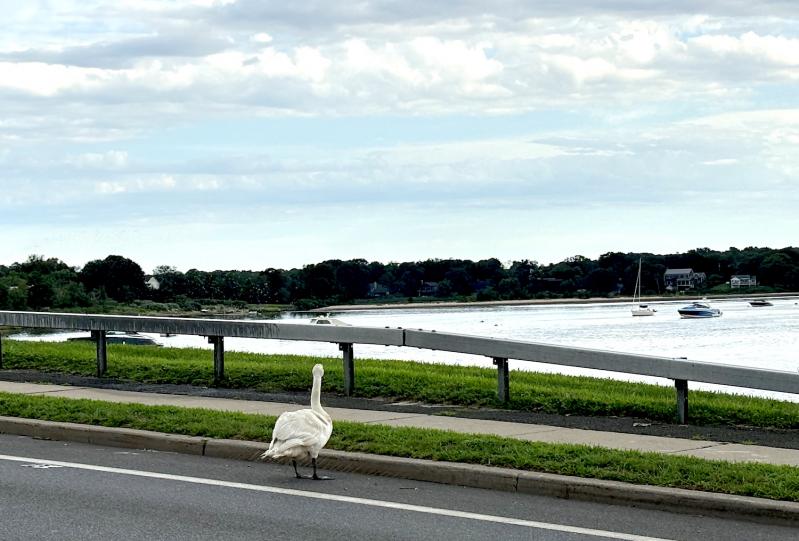What appeared at first to be a quirky but heartwarming story about a friendly mute swan that had taken to roaming the streets of Sag Harbor, often stopping traffic and interacting with people, ended tragically just a few weeks after the bird had become a summertime character on the north end of Main Street.
The village police chief, Robert Drake, confirmed after watching a video shared by Chris Keady, the dockmaster at the Waterfront Marina, that the bird was pecked and stomped to death by one of its own on Aug. 12.
“It was chased into our marina by another swan,” said Mr. Keady. “It looked like a territorial dispute. It was getting beaten up pretty badly. We had a crew member on one of the boats get the attacking swan away. The injured bird was meek; it didn’t get aggressive with us at all. I was talking with Kathleen Mulcahy, the executive director of the Evelyn Alexander Wildlife Refuge, and it sounded like this bird was familiar to them and that it may have been relocated here from somewhere else. I’ve never seen anything like it.”
“We got calls all the time about the Sag Harbor swan,” said Ms. Mulcahy, who said it was possible the bird had been relocated, but not by her organization, which is based in Hampton Bays but responds to reports of sick or injured animals across the East End. “We did many wellness checks on him. He was uninjured, so we couldn’t take him. People had been feeding him hot dogs and buns from the Harbor Shop. He was a dumpster diver.”
Kelly Duffin, the founder of the Mute Swan Society, said that swans mate for life and are very dedicated co-parents. If cygnets (juvenile swans) are present, the primary role of the cob (the male swan) during the mating season is to defend his territory. She said the average size of a mute swan’s territory is 15 acres. “There are a lot of dependencies. If there are a ton of resources, the territory can be smaller,” she said.
One morning a few weeks ago the swan was in Bay Street’s outdoor patio, seemingly unperturbed by a crew of landscapers clipping the bushes. It dipped its head and offered a soft grunt. Charming.
Ms. Duffin was familiar with the call (“The mute in their name is a misnomer. They have a quite specific call,” she said) which she said was a friendly greeting. Swans can be aggressive and have often gone after people who try to feed them in Marine Park.
“He was in the middle of the roundabout just straight up blocking traffic,” said Rob Wellener, a baker at Grindstone Coffe and Donuts, when told about the swan that morning a few weeks back. For two days, the swan stood in the middle of Windmill Beach as curious onlookers wondered. A young boy with his father observed the swan for many minutes as it preened. Accurately, the little boy named it Friend.
Lynne Palumbo, vacationing from the Hudson Valley, stood on Long Wharf speaking with another man about the swan. “I was sitting at the Corner Bar trying to have dinner with my husband last night and watched as it tried to cross the street. My first thought was that ‘There’s something wrong with it.’ “
The swan had a problem, but it wasn’t physical, it was territorial. This became clear on a subsequent morning, when the swan was sitting in the road on the bridge to North Haven. Cars were stopping. A woman walked within five feet of the resting bird, got her video, and then walked away. The police came. “I’ve come on four calls for this swan in the last couple of weeks and that’s just me,” said one of the officers. He had a long pole with a small round net on the end and worked with another officer to move the bird back toward Windmill Beach.
They succeeded. Traffic flowed again. The swan came to the retaining wall and stopped, seemingly unsure how to proceed. From across the beach, a group of onlookers started to yell. “Don’t jump! Your life is precious! Don’t do it!” Nonetheless, the swan jumped and lightly glided down to the edge of the water, proving at least, that it could fly. There was applause from onlookers, but that’s when the real trouble began.
From under the bridge another swan swam toward it. Closer it came, but the friendly swan was trapped. On the beach, officers tried to keep it in the water, but from the water its would-be murderer approached. The swan decided to risk it with the people. It left the water and sprinted, as well as a swan could, for Main Street. Politely, it used the crosswalk in front of K-Pasa, went around the building, and took a hard right toward the post office. It looked cartoonish.
The police were able to get the swan back in the water at the foot of Steinbeck Park and out of the view of the attacking cob, but the peace didn’t last. The next day was its last. “I would say it’s pretty common for them to attack each other over territory. To fight to the death is less common,” said Ms. Duffy. “Usually, the intruder swan gets the idea and leaves before that happens. I suspect this one couldn’t get away.”
Perhaps it was because the swan couldn’t get to the water to take a running start to gain flight. Ms. Duffy said they need a water runway the size of a football field to get aloft. It was a sad end to a swan that had added a bit of charm and intrigue to Sag Harbor in July and August. He got people to slow down, which is not easy to do in these parts.




